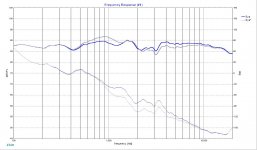The files contain the lab measurements coming from SEAS, I guess phase datas are correct!
Very, VERY bad assumption! There is no one "correct phase", as speakers work into space and the phase will vary with how far the mic is from the speaker -- phase will "roll over" faster and faster as you get further and as frequency increases. Remember, speakers are not like electronics. With electronics there is only one "output" point and you can measure the phase there. With speakers, there are an infinite number of output points (every point in space), so there are many "correct" phase curves for any speaker or driver. The main difference is delay (time of flight from driver's acoustic position to mic).
Unless the mfgr measures drivers at a fixed position from the speaker and the measurement system or technique they use provides phase with absolute delay and both speakers are to be mounted equivalently (same depth) on the baffle as when measured, then there is not really enough information there to accurately simulate a crossover except maybe at low mid or bass frequencies. Most mfgr curves I've seen appear to be adjusted to show phase at the position that makes the phase curve flattest (many measurement systems, including my Omnimic, do that inherently), which for a woofer is down near the voice coil and quite far from the baffle surface.
You can usually tell if a phase measurement was done at a fixed distance because the phase curve will have many rollovers -- positive to negative -- by 20kHz if the mic is the standard 1m away. Though there are exceptions. I got Dayton Audio to provide their phase curves to be absolute but the phase curve to be adjusted to show as if the mic were somehow at the plane of the mounting baffle surface (back surface of most driver mounts). So those at least can be used for decent simulation (and for marketing, don't show any scary looking phase rollovers in the graphs). Assuming, of course, that your simulation also includes any added delay differences such as might occur from having some drivers recessed into the baffle.
Last edited:
Yesterday I added the 1 mH coils to my build. While I don't have a second pair of A26's for fair A/B testing the difference is definitely audible even after cursory listening.
Subjectively I would say that the balance tips towards the high end, with extended detail and a more precise presentation. Previously I thought the presentation was quite dark. Now it seems more airy while still retaining that warm 70s bass.
Listening to blues (Eric Clapton - Blue Eyes Blue), jazz (Candy Dulfer - For The Love Of You), progressive rock/metal (Guilt Machine, Transatlantic) or virtuoso guitar stuff (Steve Vai) all seem more alive because the leading instruments have more presence.
Earlier Dissi suggested that the mod would induce a hump around 900 Hz. Playing around in XSim this doesn't seem the case. The image attached shows the delta in response between the original (gre) and the modded (blue) versions.
It seems that there the coil actually *decreases* the hump around 900 Hz and higher sensitivity from 2.2 up to 10 kHz. That would support my subjective findings.
So yes, I like this mod!
Subjectively I would say that the balance tips towards the high end, with extended detail and a more precise presentation. Previously I thought the presentation was quite dark. Now it seems more airy while still retaining that warm 70s bass.
Listening to blues (Eric Clapton - Blue Eyes Blue), jazz (Candy Dulfer - For The Love Of You), progressive rock/metal (Guilt Machine, Transatlantic) or virtuoso guitar stuff (Steve Vai) all seem more alive because the leading instruments have more presence.
Earlier Dissi suggested that the mod would induce a hump around 900 Hz. Playing around in XSim this doesn't seem the case. The image attached shows the delta in response between the original (gre) and the modded (blue) versions.
It seems that there the coil actually *decreases* the hump around 900 Hz and higher sensitivity from 2.2 up to 10 kHz. That would support my subjective findings.
So yes, I like this mod!
Attachments
Yesterday I added the 1 mH coils to my build. While I don't have a second pair of A26's for fair A/B testing the difference is definitely audible even after cursory listening.
Subjectively I would say that the balance tips towards the high end, with extended detail and a more precise presentation. Previously I thought the presentation was quite dark. Now it seems more airy while still retaining that warm 70s bass.
Listening to blues (Eric Clapton - Blue Eyes Blue), jazz (Candy Dulfer - For The Love Of You), progressive rock/metal (Guilt Machine, Transatlantic) or virtuoso guitar stuff (Steve Vai) all seem more alive because the leading instruments have more presence.
Earlier Dissi suggested that the mod would induce a hump around 900 Hz. Playing around in XSim this doesn't seem the case. The image attached shows the delta in response between the original (gre) and the modded (blue) versions.
It seems that there the coil actually *decreases* the hump around 900 Hz and higher sensitivity from 2.2 up to 10 kHz. That would support my subjective findings.
So yes, I like this mod!
I will try this mod too, I enjoy the sound from stock lets see what happens
- Status
- This old topic is closed. If you want to reopen this topic, contact a moderator using the "Report Post" button.
- Home
- Loudspeakers
- Multi-Way
- Seas A26 Kit - Modelled in XSim
